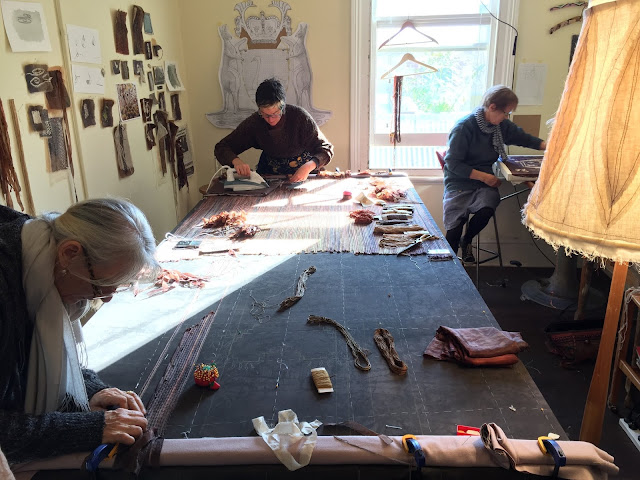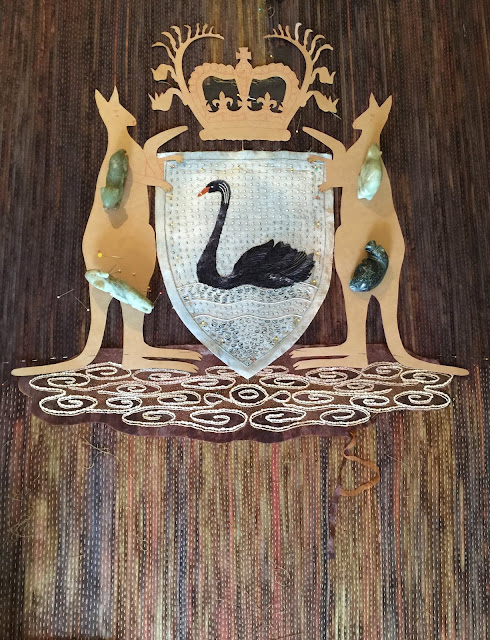At $57,000 Aus it wasn’t a big art commission by local standards, but as the Coat of Arms placed in the Ceremonial Court of the new Western Australian Supreme Court (Civil), it was an important one to get absolutely right.
The new Supreme Court Civil is part of an expanded redevelopment of Cathedral Square in the centre of the Perth Central Business District, incorporating the restoration of the beautiful, historic Old Treasury Buildings into what is now the award winning Como The Treasury Hotel. The aim of the State Government was to preserve and transform a grand and elegant heritage asset from a derelict empty building in a rundown precinct to a world-class yet publicly accessible hotel. They succeeded, the award winning restaurants and bars in this beautiful building are packed every night with the after work crowd.
This restoration became the centre of a designated Legal Precinct. An elegant, minimalist high-rise office block was built behind the hotel to house the Supreme Court (Civil) and Mediation Services, and the Departments of Justice and Treasury.
As part of the State Government Percent for Art Scheme, site-specific art commissions were already underway for these new offices and courts when the Chief Justice suggested one more. He had seen a tapestry Coat of Arms, albeit old and falling apart, in another Australian State’s Supreme Court and thought we should have something similar.
 |
| Madam Bukleshla Crown - close-up |
As part of the State Government Percent for Art Scheme, site-specific art commissions were already underway for these new offices and courts when the Chief Justice suggested one more. He had seen a tapestry Coat of Arms, albeit old and falling apart, in another Australian State’s Supreme Court and thought we should have something similar.
Another Supreme Court Judge, who has an interest in the local art scene, took over the project. He and the Executive Manager of the Supreme Court were a pleasure to work with. It was an act of great faith and trust for them to commission Trish Bygott and Nathan Crotty as neither had any previous experience with public art projects and Trish’s embroidery work is completely process driven so they could only present a loose and imprecise concept when they pitched for the project.
 |
| The Wild Side of The Swan |
As a young artist Trish came to Western Australia from Melbourne over 25 years ago for a six months residency, but never left. She describes herself as a ‘Crafter of cloth. Stitch-ress of beauty’. Artisan of adornment’ and says ‘I learnt to hand stitch at the age if 6…. then honed my love of textile design in Melbourne’s RMIT in the early eighties and found myself exhibiting a naïve, personal narrative celebrating stich and adornment for another time’
 |
| Trish making a start with the background construction |
Nathan Crotty is Trish’s partner in life and art. He contributed to the overall design and more difficult aspects of project management that required lateral thinking. From their shop selling hand-stitched clothes in Fremantle, (the port suburb and artists’ hub of Perth), they have gathered a group of like-minded passionate stitchers to give workshops and seminars on embroidery and associated crafts.
 |
| Hands at Work - Long Stitch Details for Kangaroo |
 |
| Finalising the background around the crest |
When the
State and Judiciary of Western Australia were founded any Indigenous
perspective was completely denied. The symbols we are left with for the most part
reflect outmoded sentiments around this division. It was important to Trish and
Nathan to correct this in some way, no matter how subtle. They contacted
respected Noongar[1]
Elder Dr. Noel Nannup, who graciously shared his wisdom. Although many of the symbols
within the crest do not sit well with Noongar people, Noel talked about the significance
of the Sheoak tree[2]
as a natural and living symbol of justice for his country and culture.
Uncannily yet appropriately the filament-like leaves of this tree have a
stitch-like appearance. This information was crucial as it allowed the essence
of Noel’s narrative to consciously enter the new Coat of Arms and infuse every
aspect of the process, embedding a deeper layer of meaning and sensitivity into
every colour and stitch within the work.[3]
 |
| Nicole Demarchelier working on the background- the spirit of the sheoak |
Before
starting on the embroidery Trish tested numerous samples inside the Ceremonial
Court to confirm that proposed stitch sizes could be seen at a distance while
still maintaining a sense of intimacy. Silks and threads hand dyed in natural
and reactive dyes were placed against the wood to ensure each complemented the other
yet allowed the embroidery to stand apart.
Everything
had to be drawn to scale because the drawn marks determined the stitch size. Once
this process was resolved Trish engaged two expert embroiderers to work with
her. Each took on responsibility for individual parts of the whole work.
 |
| Dr. Nicole Demarchelier. Bridget Bygott, and Dr. Jane Donlin ( left to right ) |
Before
commissioning the artwork, the architect had designated leather as the
background material for the Coat of Arms.
However, to ensure overall aesthetic cohesion Trish and Nathan decided
to replace this with textile created from thin strips of torn silk hand dyed in
nuanced shades of earth and amber. Each
strip, meticulously folded to ensure no raw edges were revealed was laid down
held was laid down and held in place with and estimated 40,000 minute running
stitches. At over 2m in length the background was hard to handle and their
first attempt was thwarted because the fabric was distorting. Textile artist,
Jane Donlin, who was working on the project with Trish and Nathan suggested the
strips had to be held tight like a warp of a woven cloth Overnight Nathan made
a special frame on table legs while Trish and Nicky Desmarchelier, another
textile artist who was responsible for stitching the background, unpicked their
work to start over again. All of this added to stress and adrenalin levels.
 |
| Hands At Work, Stitching the background Silk in Place |
The kangaroo
paws,[4]
kangaroo, fleur-de-lis, water, and crest with the swan were embroidered
separately, cut out and appliqued onto the background. Trish had to design around stitches that would
allow for the body of each element to be easily cut and turned. The ground of
spirals below the kangaroos give the work a three-dimensional feel.
Trish
engaged a textile conservator to mount the finished work. The architect
provided the original backing board for the leather, but it is MDF
(medium-density fibreboard), which is definitely not acid free. To rectify this Nathan had to glue a thin
layer of rag board to the MDF to act as a barrier between the acids and the finished work. Then it was wrapped
with a layer of bamboo wadding, and covered with another layer of de-ionised
linen. Only after all this preparation could the artwork be mounted.
 |
| Readying the placement of the central components on the background |
Everything
was measured very precisely. The completed artwork was stitched onto the linen
which already had Velcro stitched on to hold it under the board. The four
corners had to be very carefully mitred. This final mounting turned out to be
an all night task right up until the van came to take it into the Court at
11.00 am.
 |
| detail of the ground stitched onto the background |
‘The whole process was so intense from start
to finish’, Trish said ‘no matter how careful our planning, we still had to
make on the spot decisions every day. It was a balancing act because even
though we knew we were working against the clock to a strict deadline, nothing
could be forced and we had to allow each and every part to come together at the
right time. After the artwork went up in the court, we all went through a
strange phase of having withdrawal symptoms. We were all so exhausted yet
didn’t know how to relax, sleep or conversely how to fill our days’.
 |
| Irina and Alena, stitching the crown in place with surgical precision |
Stitches
Background: Torn silk strips
held down with running stitch;
Earth: ripped silk
backstitch held down by running stitch, seed stitch, and stem stitch;
Crown: a combination
of satin stitch and backstitch using ripped silk rather than thread;
Ermine: ripped silk held down with running stitch;
Fleur de lis:
feather stitch;
Kangaroo: ripped silk
held down with running stitch, backstitch, and long satin stitch;
Kangaroo paws:
couching;
Shield: satin stitch (405 squares), and stem stitch;
Swan: ripped silk
feather stitch and long and short stitch; and
Water: ripped silk held
down with running stitch, ripped silk backstitch.
If
you would like to know more about this artwork, tune into the short video made
by Rob Bygott to document the processes from start to finish: https://youtu.be/oi3zptf_g1w
Or
read ‘Crest-Risen in the Supreme Court by Nathan Crotty in The Fremantle
Shipping News, Feb 24 2017: http://fremantleshippingnews.com.au/2017/02/24/the-crest/
For a
short video about the other art commission for the Supreme Court Civil:
‘Journey of a River’ (an18 m long
painting + 5 x 20m long glass panels) by Jo Darbyshire in collaboration in Rick
Vermey go to: https://youtu.be/wFkEAXmrw1w
ACKNOWLEDGEMENTS
Artist:
Trish Bygott in collaboration with Nathan Crotty, Dr. Nicolle Desmarchelier, and
Dr. Jane Donlin,
Title:
State Coat of Arms
Architect:
Peter Hunt Architect
Art
Coordinator: Maggie Baxter
Photography:
Robert Frith
Textile
Conservation: Patricia Moncrieff
Client:
The Department of Justice
Department
of Finance Project Managers: Grayam Sandover and Louise Armstrong
The
artist would like to thank the Western Australian Government Department of Finance
and Rob Bygott for their support in making the video. ‘Coat of Arms
Embroidery’.
[1]. The Noongar are the original
Indigenous inhabitants of south-west corner of Western
Australia. They have inhabited this area for more than 45,000 years. Their
traditional lands include the metropolitan area of Perth, Western Australia’s
capital city.
[2] . A
species of the Casuarina genus, native to Australia, the Indian Sub-Continent,
South east Asia, and the Pacific Islands.
[3]. This paragraph has been extrapolated and slightly
re-worked from an article by Nathan Crotty for the Fremantle Shipping News.
[4]. The
common name for a number of plant species found in the south west of Australia
so named because the tubular flowers are coated with dense hairs and
open at the apex with six claw-like structures. The red and green kangaroo paw
is the official floral emblem for Western Australia.




Hi, Maggie, Trish and Nathan, what a wonderful project - so rich in content and process. I was curious about 'Madam Bukeshla'. The captions refer to her but there is nothing about this in the text. Who is she and what is her relationship to the crest?
ReplyDeleteMadam Bukeshla is the name of Trish's business
DeleteAnother question: What are the dimensions of the crest? And I would love to know about the significance of the Sheok Tree in indigenous cultures and how this has been carried forward in contemporary times.
ReplyDelete